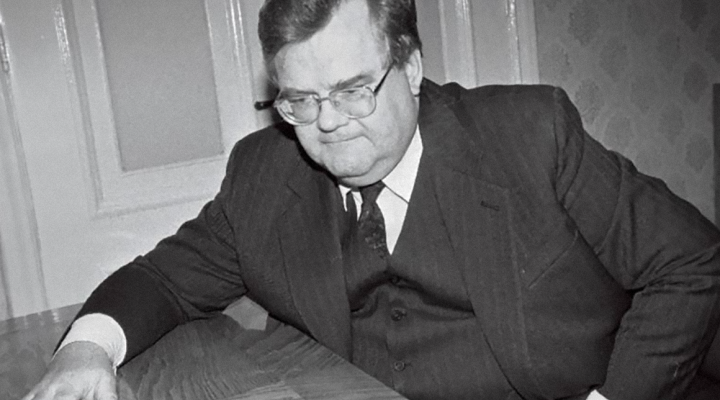One of the leaders of the restoration of the independence of Estonia
Edgar Savisaar had a very important role in restoring the independence of Estonia. Namely, he came up with the idea of forming the Popular Front in the TV series Mõtleme veel in 1988. He became one of the leaders of the singing revolution. He was also one of the main organisers of the Baltic Way.
On 3 April 1990, Savisaar became the head of the transitional government (the prime minister, in current terms) of Estonia. His term of office included finding widespread support for the people’s representatives in Toompea, both domestically and abroad, and the peaceful restoration of independence on 20 August 1991. On 30 January 1992, the government of Savisaar resigned due to the conflicts resulting from the economic crisis, hyperinflation, and shortage of goods. Considering the legal continuity of the independence of Estonia, it was the 34th Government of the Republic.
Long-time shaper of the Estonian political party landscape
On the initiative of Edgar Savisaar, the Estonian Centre Party was founded by the active members of the Popular Front on 12 October 1991. Savisaar became the leader of the Centre Party. With the exception of a half-year interim period from 1995 to 1996, Savisaar led the Centre Party for nearly 25 years, making him the longest-serving party leader in Estonia. On 6 November 2016, the Congress of the Centre Party elected Jüri Ratas as the new chairman.
In the 1992 Riigikogu elections, Savisaar received 4,678 votes and entered parliament with a personal mandate. He was elected a member of the Riigikogu five times in 1992–2007.
On 22 September 1995, a tape scandal related to Edgar Savisaar broke out. Savisaar was accused of secretly recording political consultations held with Prime Minister Tiit Vähi and Reform Party chairman Siim Kallas. He denied the accusations, but resigned from both the position of the Minister of the Interior and party leader. His then-assistant Vilja Laanaru took the blame for the scandal. Savisaar returned to politics after a few months, becoming the chairman of the Tallinn City Council in 1996.
In the election of the IX composition of the Riigikogu in 1999, the Centre Party received the most mandates in the Riigikogu (28 out of 101), but the coalition was instead formed by Isamaa, the Reform Party, and Mõõdukad (now the Social Democratic Party). His period of leadership was made remarkable by the K-Kohuke campaign, several cases of corruption, and opposition to the state power in Toompea.
In 1995, Edgar Savisaar was the Minister of the Interior in the government of the Coalition Party, the association Maarahva Ühendus, and the Centre Party led by Tiit Vähi, and in 2005–2007, he was the Minister of Economic Affairs and Communications in the government of the Reform Party, the Centre Party, and the People’s Union of Estonia led by Andrus Ansip. In the latter role, he founded the Estonian Development Fund.
Edgar Savisaar has a son, Erki, from his first marriage, a daughter, Maria, and a son, Edgar, from his second marriage, and a daughter, Rosina, from his third marriage. Savisaar lived in the Hundisilma Farm in Lääne-Viru County after his health deteriorated and he withdrew from public life.
Savisaar graduated in 1973 from the Faculty of History and Languages of Tartu State University as a historian, worked as a teacher at the Ahja upper secondary school from 1973 to 1976, and was the deputy group commander of the student summer camp of the Leninist Young Communist League of Estonia from 1976. In 1980, he became a candidate of philosophy with his dissertation ‘The Social Philosophical Foundations of Global Models of the Club of Rome’.
Edgar Savisaar was recognised with the Order of the National Coat of Arms, second class, in 2001 and the Order of the National Coat of Arms, first class, in 2006. In 2003, he was bestowed the Latvian Order of the Three Stars and in 2008, the Dutch Order of Orange-Nassau.
*
The 34th composition of the Government of the Republic consisted of the ministers of the Popular Front and the Coalition Party. The government took office on 3 April 1990 and was in office for a total of 668 days, i.e. until 30 January 1992.
- Chairman Edgar Savisaar
- Minister of Material Resources Aleksander Sikkal (17 April 1990 – 31 December 1991)
- Minister of Construction Gennadi Golubkov (11 April 1990 – 30 January 1992)
- Minister of Social Care Siiri Oviir (25 April 1990 – 30 January 1992)
- Minister of Culture Lepo Sumera (10 April 1990 – 30 January 1992)
- Minister Artur Kuznetsov (24 April 1990 – 29 November 1991)
- Minister of Agriculture Harry Õunapuu (13 February 1991 – 30 January 1992)
- Minister of Education Rein Loik (11 April 1990 – 30 January 1992)
- Minister of State Raivo Vare (17 April 1990 – 30 January 1992)
- Minister of Health Andres Ellamaa (10 April 1990 – 30 January 1992)
- Minister of Economic Affairs Jaak Leimann (11 April 1990 – 30 January 1992)
- Minister of Transport (later Minister of Transport and Communications) Tiit Vähi (11 April 1990 – 30 January 1992)
- Minister of Agriculture Vello Lind (7 May 1990 – 13 February 1991)
- Minister of Justice Jüri Raidla (17 April 1990 – 30 January 1992)
- Minister of Social Affairs (later Minister of Labour) Arvo Kuddo (17 April 1990 – 30 January 1992)
- Minister of Trade Aleksander Sikkal (1 January 1992 – 30 January 1992)
- Minister of Communications Toomas Sõmera (25 April 1990 – 20 June 1991)
